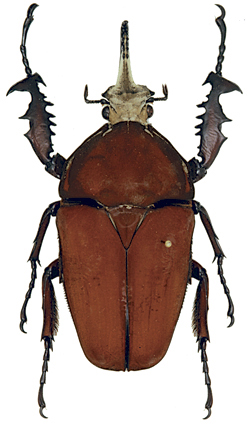|
Narycius
''Narycius opalus'' is a flower chafer beetle that is endemic to the Western Ghats of India. It is the sole species in the genus. The adult male has a prominent projection on the head, while the female has a much shorter horn. This structure is probably the result of sexual selection, as in similar beetles. The adult beetle is shiny iridescent rose ranging to green, with intermediates. The species was described and given its name by Henry Dupont who also described the females as a separate species, named ''Narycius olivaceus''. Westwood named the green color form as ''Narycius (Cyphonocephalus) smaragdulus''. This beetle is about 2 to 2.5 cm long and 1.3 cm wide. The distinctive cephalic horns may be nearly two-thirds the length of the thorax and abdomen combined. The surface is matt and the elytra are minutely pitted along lines. The prothorax The prothorax is the foremost of the three segments in the thorax of an insect, and bears the first pair of legs. Its p ... [...More Info...] [...Related Items...] OR: [Wikipedia] [Google] [Baidu] |
Flower Chafer
Flower chafers are a group of scarab beetles, comprising the subfamily Cetoniinae. Many species are diurnal and visit flowers for pollen and nectar, or to browse on the petals. Some species also feed on fruit. The group is also called fruit and flower chafers, flower beetles and flower scarabs. There are around 4,000 species, many of them still undescribed. Twelve tribes are presently recognized: Cetoniini, Cremastocheilini, Diplognathini, Goliathini, Gymnetini, Phaedimini, Schizorhinini, Stenotarsiini, Taenioderini, Trichiini, Valgini, and Xiphoscelidini. The tribe Gymnetini is the biggest of the American tribes, and Goliathini contains the largest species, and is mainly found in the rainforest regions of Africa. Description Adult flower chafers are usually brightly coloured beetles, often metallic, and somewhat flattened in shape. The insertions of the antennae are visible from above, while the mandibles and labrum are hidden by the clypeus. The elytra lack a na ... [...More Info...] [...Related Items...] OR: [Wikipedia] [Google] [Baidu] |
Cetoniinae
Flower chafers are a group of scarab beetles, comprising the subfamily Cetoniinae. Many species are diurnal and visit flowers for pollen and nectar, or to browse on the petals. Some species also feed on fruit. The group is also called fruit and flower chafers, flower beetles and flower scarabs. There are around 4,000 species, many of them still undescribed. Twelve tribes are presently recognized: Cetoniini, Cremastocheilini, Diplognathini, Goliathini, Gymnetini, Phaedimini, Schizorhinini, Stenotarsiini, Taenioderini, Trichiini, Valgini, and Xiphoscelidini. The tribe Gymnetini is the biggest of the American tribes, and Goliathini contains the largest species, and is mainly found in the rainforest regions of Africa. Description Adult flower chafers are usually brightly coloured beetles, often metallic, and somewhat flattened in shape. The insertions of the antennae are visible from above, while the mandibles and labrum are hidden by the clypeus. The elytra lack a n ... [...More Info...] [...Related Items...] OR: [Wikipedia] [Google] [Baidu] |
Henry Dupont
Richard Henry Puech Dupont or Henry Dupont (1 November 1798 – 2 July 1873) was a French Natural history, naturalist and a collector and trader in specimens of beetles and birds. He was the younger brother of the naturalist Leonard Dupont and many references in old French works merely mention Monsieur Dupont which has led to confusion between the two although in some works Leonard is referred to as the senior Dupont senior (aîné) and Henry as the younger (jeune). For the larger part Henry was into beetles and entomology while Leonard was more associated with birds. Many species of beetle were named by Henry Dupont and some are named after him by others. Henry or Henri was born at Bayeux on 1 November 1798 (Leonard on 10 January 1796) to wig-maker Jean-Antoine Puech dit Dupont and his wife Marie-Francoise Badin. They were Baptism, baptized with the surname Puech dit Dupont but in later life they were known only as Dupont. Both the boys (a third died young) were interested in nat ... [...More Info...] [...Related Items...] OR: [Wikipedia] [Google] [Baidu] |



